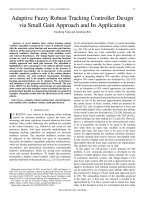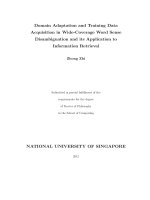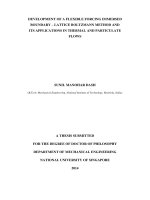textile composites and its application
Bạn đang xem bản rút gọn của tài liệu. Xem và tải ngay bản đầy đủ của tài liệu tại đây (523.49 KB, 40 trang )
COMPOSITES
BY ALANKAR G. MHATRE
FINAL YEAR B.TECH
CONTENTS
•
Introduction
•
What are composites?
•
Composition of composites
•
Types of composites
•
Manufacturing and forming methods
•
Applications
•
Composites Today's Material of Choice
•
Properties of composites
•
Key manufacturers of composite products
•
References
INTRODUCTION TO COMPOSITES
You might be know we all are surrounded by composites in day today life.
Everybody comes across composites in his daily life.You might be playing
tennis or badminton with a "graphite racket", You might have a "carbon bike"
,your bike breaks are made of composite, several parts of your car body
are also made of composites.
Def :-A composite is a material made up of two or more different materials
that are combined in a way that allows the materials to stay distinct and
identifiable.
The purpose of composites is to allow the new material to have strengths
from both materials.
•
Composites can be easily found in nature. Wood is an example of a
composite . Another natural composite is rock and sand, materials used in
concrete.
Properties of composites like stiffness, thermal expansion etc. can be
varied continuously over a broad range of values using appropriate
fiber , resin and fabrication mechanism.
The technical textile material in the composites is the fiber glass,
aramid and carbon fiber.
•
Fibre glass dominates the composites industry as a preferred
reinforcement fibre, with a share of around 85%-90%. Other
reinforcement fibers like carbon fibre and aramid fibre are sparingly
used in India.
WHAT ARE COMPOSITES?
Composites are created by combining two or more materials to
produce a new material that retains important properties from the
original elements .
Reinforcing fibers give composites the attributes of high strength
and stiffness.
In textile composites fibers are surrounded by a choice of polymers
that act as a support system.
Composites are produced by reinforcing a resin matrix
(thermoplastic/thermoset) with fibres like glass fibre, aramid, carbon
fibre and/or natural fibres.
A common example of a composite is concrete. It
consists of a binder as a cement and a reinforcement as
a gravel.
COMPOSITION OF COMPOSITES
The individual materials that make up composites are called
constituents. Most composites have two constituents, a matrix and
reinforcement.
Composite materials are usually classified by the type of
reinforcement they use. This reinforcement is embedded into a matrix
that hold it together.
The reinforcement is used to strengthen the composite. Composite
properties are best in the direction of the fibers. Perpendicular, or
transverse, to the fibers, the matrix properties dominate because load
must be transferred by the matrix every fiber diameter.
Reinforcement
The reinforcement is usually much stronger and stiffer than the matrix, and
that gives the composite its good properties.
The matrix hold the reinforcements in an orderly pattern, the matrix also
helps to transfer load among the reinforcements.
Reinforcements basically come in three forms: particulate, discontinuous
fiber, and continuous fiber.
PARTICLE AS A REINFORCEMENT:-A particle has roughly
equal dimensions in all directions, though it doesn't have to be spherical.
Gravel, micro balloons, and resin powder are examples of particulate
reinforcements.
CONTINUES FIBER AS A REINFORCEMENT:-Reinforcements
become fibers when one dimension becomes long compared to others.
DISCONTINUES FIBERS AS A REINFORCEMENT:
-:Discontinuous reinforcements (chopped fibers, milled fibers, or whiskers)
vary in length from a few millimeters to a few centimeters. Most fibers are
only a few microns in diameter, so it doesn't take much length to make the
transition from particle to fiber.
MATRIX
Matrix materials are usually some type of plastic, and
these composites are often called reinforced plastics.
There are other types of matrices, such as metal or
ceramic, but plastics are the most .
The two most common plastic matrices are epoxy
resins and polyester resins.
TYPES OF COMPOSITES
Metal matrix composites (MMC)
Ceramic matrix composites (CMC)
Polymer matrix composites (PMC)
Metal matrix composites (MMC)
•
Metal matrix composites (MMCs) are a subgroup of composite materials.
Composition:-
MMC are made by dispersing a reinforcing material into a metal matrix. The
reinforcement surface can be coated to prevent a chemical reaction with the
matrix.
For example, carbon fibers are commonly used in aluminum matrix
to synthesize composites showing low density and high strength. However,
carbon reacts with aluminum to generate a brittle and water-soluble
compound Al4C3 on the surface of the fiber. To prevent this reaction, the
carbon fibers are coated with nickel or titanium boride.
Matrix:-
In structural applications, the matrix is usually a lighter metal such as
aluminum, magnesium, or titanium, and provides a compliant support for
the reinforcement.
In high temperature applications, cobalt and cobalt-nickel alloy matrices are
common.
Reinforcement to MMC
The reinforcement can be either continuous, or discontinuous
Discontinuous MMC can be isotropic, and can be worked with
standard metalworking techniques, such as extrusion, forging or
rolling.
In addition, they may be machined using conventional techniques,
but commonly would need the use of polycrystalline diamond tooling
(PCD).
Continuous reinforcement uses monofilament wires or
fibers such as carbon fiber or silicon carbide.
One of the first MMC used boron filament as
reinforcement. Discontinuous reinforcement uses
"whiskers", short fibers, or particles.
The most common reinforcing materials in this category
are alumina and silicon carbide.
Ceramic matrix composites
Ceramic matrix composites (CMCs) are a subgroup of composite
materials as well as a subgroup of technical ceramics.
They consist of ceramic fibers embedded in a ceramic matrix, thus
forming a ceramic fiber reinforced ceramic (CFRC) material.
The matrix and fibers can consist of any ceramic material, whereby
carbon and carbon fibers can also be considered a ceramic
material.
Generally, CMC names include a combination of type of fiber / type
of matrix. For example, C/C stands for carbon-fiber-reinforced
carbon (carbon/carbon), or C/ SiC for carbon-fiber-reinforced
silicon carbide.
Ceramic composites
REINFORCEMENT- SiC (Silicon carbide)
MATRIX-Cu Metal
Polymer Matrix composites
Polymer matrix composites are the imp and third subgroup of
composites.
It is also referred as fibre-reinforced plastics(FRP)
In these fibre-reinforced plastics, the plastic is reinforced with
fibers to make a light and strong material. The material in
which the fibres are embedded, is called the matrix, while the
fibres are called the reinforcement.
The matrix can basically be any type of plastic: epoxy, polyester,
vinyl ester, polypropylene (PP).
Matrix examples for PMC
•
Thermosetting resins
•
Epoxy
•
unsaturated polyester
(UP)
•
Vinylester
•
polyurethane (PUR)
•
phenolic resin
•
acrylic resin
•
Thermoplastic resins
•
polypropylene (PP)
•
thermoplastic polyesters
(PET, PBT)
•
polyether sulphide (PES)
•
polyphenylene sulphide
(PPS)
•
polyether imide (PEI)
•
polyether ether ketone
(PEEK)
The fibres are typically glass, carbon (graphite) or aramid (trade
name Kevlar). The fibre reinforcement can take any form: a mat
of short chopped fibres, a woven fabric, a unidirectional
arrangement of fibres, a braid, a knit.
Glass fabrics Plain weave glass
fabric
Manufacturing and forming methods of
MMC
MMC manufacturing can be broken into three types: solid,
liquid, and vapor.
Solid state methods:-
1)-Powder blending and consolidation (powder metallurgy):-
Powdered metal and discontinuous reinforcement are mixed
and then bonded through a process of compaction, degassing,
and thermo-mechanical treatment (possibly via hot isostatic
pressing (HIP) or extrusion).
2)-Foil diffusion bonding:-Layers of metal foil are
sandwiched with long fibers, and then pressed through to form
a matrix.
Liquid state methods FOR MMC
1)-Electroplating / Electroforming:- A solution
containing metal ions loaded with reinforcing particles is
co-deposited forming a composite material.
2)-Stir casting:- Discontinuous reinforcement is stirred
into molten metal, which is allowed to solidify.
3)-Squeeze casting:- Molten metal is injected into a
form with fibers preplaced inside it.
4)-Spray deposition:- Molten metal is sprayed onto a
continuous fiber substrate.
5)-Reactive processing:- A chemical reaction occurs,
with one of the reactants forming the matrix and the
other the reinforcement.
Vapor deposition
Physical vapor deposition: The fiber is
passed through a thick cloud of vaporized
metal, coating it.
Manufacturing procedures for Ceramic
matrix composites
1)-Matrix deposition from a gas phase:-
Chemical vapor deposition (CVD) is well suited for this purpose.
In the presence of a fiber perform, CVD takes place in between the fibers
and their individual filaments and therefore is called chemical vapor
infiltration (CVI).
One example is the manufacture of C/C composites: a C-fiber perform is
exposed to a mixture of argon and a hydrocarbon gas (methane, propane,
etc.) at a pressure of around or below 100 kPa and a temperature above
1000 °C.
2)-Matrix forming via pyrolysis of C- and Si-containing polymers-
Hydrocarbon polymers shrink during paralysis, and upon out gassing form
carbon with an amorphous, glass-like structure, which by additional heat
treatment can be changed to a more graphite-like structure.
Other special polymers, where some carbon atoms are replaced by
silicon atoms, the so-called polycarbosilanes, yield amorphous silicon
carbide of more or less stoichiometric composition.
•
Subsequent curing and pyrolysis yield a highly porous matrix, which is
undesirable for most applications. Further cycles of polymer infiltration and
pyrolysis are performed until the final and desired quality is achieved.
Usually five to eight cycles are necessary .
The process is called liquid polymer infiltration (LPI), or polymer
infiltration and pyrolysis (PIP). Here also a porosity of about 15% is
common due to the shrinking of the polymer. The porosity is reduced after
every cycle.
APPLICATION OF COMPOSITES
•
Applications of Métal matrix composites (MMC)–
1. Carbide drills are often made from a tough cobalt matrix with hard tungsten
carbide particles inside.
2. Some tank armors may be made from metal matrix composites, probably steel
reinforced with boron nitride. Boron nitride is a good reinforcement for steel
because it is very stiff and it does not dissolve in molten steel.
3. Honda , Toyotas automobiles has used aluminum metal matrix composite
cylinder liners in some of their engines,
4. Specialized Bicycles has used aluminum MMC compounds for its top of the
range bicycle frames for several years. Griffen Bicycles also makes boron
carbide-aluminum MMC bike frames, and Univega briefly did so as well.
5. Some automotive disc brakes use MMC. Modern high-performance sport
cars, such as those built by Porsche, use rotors made of carbon fiber
within a silicon carbide matrix because of its high specific heat and
thermal conductivity.
A typical composites material construction
for helicopter blade









